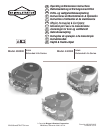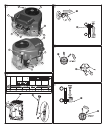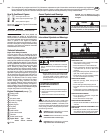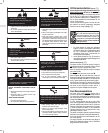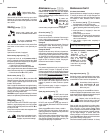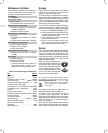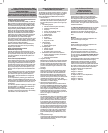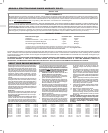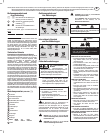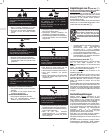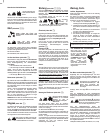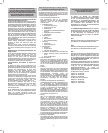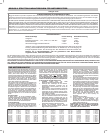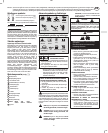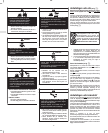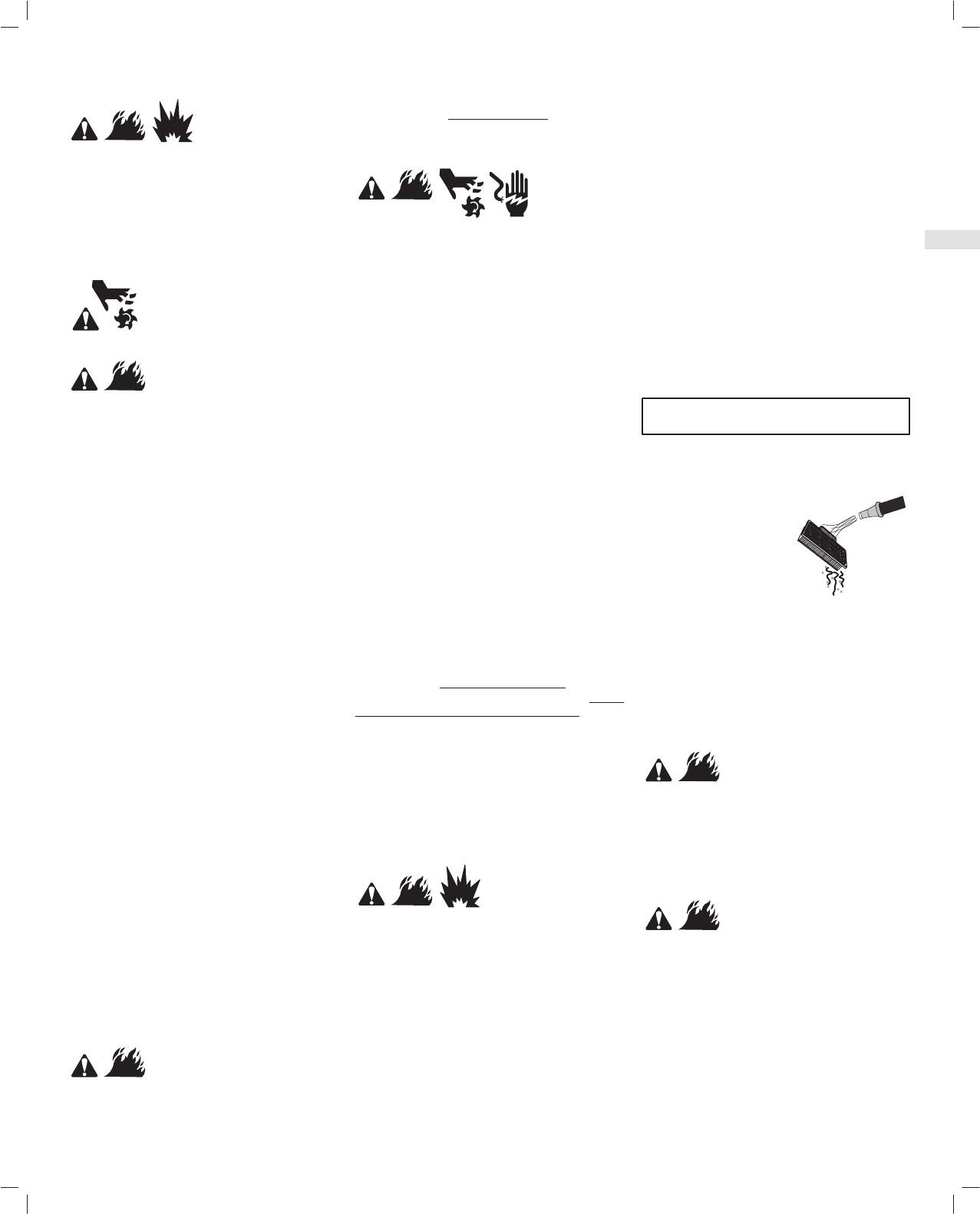
GB
3
Check fuel level.
Before refueling, allow
engine to cool 2 minutes.
Clean around fuel fill before removing cap to refuel.
Remove cap. Fill tank to approximately 1‐1/2 inches
below top of neck to allow for fuel expansion. Be careful
not to overfill.
Starting (see figs. )
ALWAYS KEEP HANDS AND FEE
T
CLEAR OF EQUIPMENT MOVING PARTS.
Do not use a pressurized starting
fluid. Vapors are flammable.
Start, store and fuel lawn mower in level position. Start
lawn mower on hard surface or over previously cut
grass.
Check oil level.
Open fuel shut‐off valve, if equipped.
Before starting engine
(see fig. )
If engine runs low on oil, an oil pressure switch (if
engine is equipped) will activate a warning light. (Read
the operating instructions supplied by the equipment
manufacturer.) See Oil pressure.
1. Open fuel shut‐off valve, if equipped.
2. Move choke control to CHOKE position
Ê.
Note: If engine does not start, remove air cleaner to check
choke. Choke must fully close. If not, see Adjustments.
3. Move throttle control
Ë to FAST position.
Electric starter (see fig. )
Turn key to START position
Ê or press button Ë.
Repeat if necessary with choke off and throttle control
in FAST position. Operate engine with choke off and
throttle in FAST position.
Note: If equipment manufacturer has supplied battery,
charge it before trying to start engine, as equipment
manufacturer recommends. Use short starting cycles
(15 secs. per min.) to prolong starter life. Extended
cranking can damage starter motor.
CAUTION:If engine is equipped with battery for electric
starter, do not operate engine with battery disconnected.
Stopping (see fig. )
Do not move choke control to CHOKE to stop engine.
Backfire or engine damage may occur. Move throttle
control to IDLE or SLOW position, then to STOP
Ê or
turn key to OFF
Ë.
Always remove key from switch when equipment is not
in use or left unattended.
When engine or equipment is trans‐
ported, close fuel shut‐off valve, if
equipped, to prevent fuel leakage.
Maintenance (see figs. )
Also, see Maintenance Schedule. Follow the hourly or
calendar intervals, whichever occur first. More frequent
service is required when operating in adverse conditions.
See any Authorized Briggs & Stratton Dealer for correct
replacement parts.
To prevent acci‐
dental starting, re‐
move spark plug
wire Ê and
ground it before
servicing, and dis‐
connect battery at negative terminal, if equipped.
Oil service
(see fig. )
Check oil level regularly.
Be sure correct oil level is maintained. Check every 8
hours or daily, before starting engine. See oil filling
procedure, Oil Recommendations.
Change oil.
Change oil after first 8 hours of operation. Change oil
while engine is warm. Refill with new oil of recom‐
mended SAE viscosity grade. (see fig.
)
Change oil filter
Ë
Replace oil filter after every 100 hours of operation or
every season, whichever occurs first. Before installing
new filter, lightly oil filter gasket with fresh, clean engine
oil. Screw filter on by hand until gasket contacts oil filter
adapter. Tighten 1/2 to 3/4 turn more. Start and run
engine at IDLE to check for oil leaks. Stop engine.
Recheck oil level and add oil if required.
Oil pressure
If oil pressure drops below 4‐6 psi (.2‐.4 kg/cm
2
), an oil
pressure switch (if engine is equipped) will either
activate a warning device or stop the engine. Check oil
level with dipstick. If oil level is between ADD and FULL
mark on dipstick, do not try to restart engine
. Contact an
Authorized Briggs & Stratton Service Dealer. Do not
operate engine until oil pressure is corrected.
If oil level is below ADD mark on dipstick, add oil to bring
level to FULL mark. Restart engine and check oil
pressure. If pressure is normal, continue to operate
engine.
Note: Oil pressure gauge, if engine is equipped, is
supplied by manufacturer of equipment.
Spark plug service
(see fig. )
DO NOT check for spark
with spark plugs removed.
Use only Briggs & Stratton
Spark Tester Ë, to check
for spark.
DO NOT crank engine with spark plug removed. If
engine is flooded, place throttle in FAST and crank until
engine starts.
Spark plug gap
Ì should be .76 mm or 0.030 in.
Replace spark plugs every season. Spark tester and
spark plug wrench are available from any Authorized
Briggs & Stratton Service Dealer.
Note: In some areas, local law requires using a resistor
spark plug to suppress ignition signals. If this engine
was originally equipped with resistor spark plug, use
same type of spark plug for replacement.
Maintenance Cont'd
Air cleaner, dual element
Replace pre‐cleaner or cartridge if very dirty or damaged.
To service pre‐cleaner, wash in liquid detergent and
water. Squeeze dry in a clean cloth. Saturate in engine
oil. Squeeze in clean, absorbent cloth to remove
excess oil.
1. See illustrations (see fig.
) for disassembly
and reassembly of your air cleaner style.
2. Carefully remove air cleaner cartridge and pre‐
cleaner, preventing debris from entering carbure‐
tor.
3. Install pre‐cleaner (if equipped) in base with
mesh side up.
4. Install cartridge on pre‐cleaner.
5. Replace cover. To ensure proper fit, tabs must be
hooked into slots. Tabs are painted a different
color in some instances.
6. Latch handle or tighten knobs completely to
secure cover.
CAUTION: Improper installation of air cleaner
cover may cause damage to engine.
EXTENDED
LIFE
SERIES
™
CARTRIDGE
ONLY
This filter, IF STAMPED
`WASHABLE', can be
washed with mild soap in
warm water. IMPORTANT:
Rinse in tap water with
SCREEN side up allowing
dirt and debris to filter out.
Leave filter to dry overnight
before reinstalling.
Keep engine clean (see fig. )
Periodically remove grass/chaff buildup from engine.
Do not spray engine with water because water could
contaminate fuel. Use a brush or compressed air.
Accumulation of debris around ex‐
haust manifold/muffler
Í could
cause a fire. Inspect and clean
before every use.
Keep linkage, springs and controls
Í free of debris.
If muffler is equipped with spark arrester screen, remove
spark arrester screen for cleaning and inspection every 50
hours or every season. Replace if damaged.
Replace in‐line fuel filter Ï every
season. Drain fuel tank or close fuel
shut‐off valve before replacing filter.
Grass or chaff may clog engine's air cooling system,
especially after prolonged service cutting tall, dry grass.
Every 100 hours or every season remove rotating
screen, air cleaner cover
and blower housing Ï to clean
internal cooling fins and surfaces to prevent overheat‐
ing and engine damage. To prevent debris from
entering carburetor, it is important to cover the carbure‐
tor air intake
Ð located above and behind carburetor
(inset) when cleaning cooling system.
Check valve clearance (intake and exhaust .10‐.15mm)



